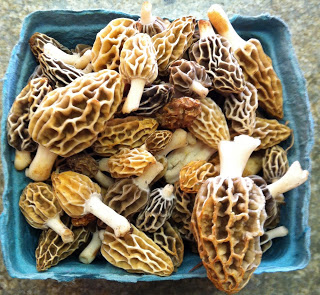Eggs, formerly the kick-me of dairy, are riding the protein trend all the way to the table. I thought eggs were ok, nothing to write about. But Mary Dunbar’s eggs are anything but mundane. They are velvety, both intense and fluffy at the same time, and the way they pop and crackle in butter when sprinkled with sea salt is the kind of thing worth crawling out from under the duvet for.
Mary Dunbar’s farm is just outside our town. She and her husband were computer programmers, “desk jockeys,” as she says, “totally stressed out.” So they quit and procured 22 rolling Virginia acres, which today are bathed in cold clear sunlight, the winter fields fallow and gold, the distant Blue Ridge glowing smoky purple.
“We wanted to see if we could provide ourselves with food,” she says, in her farmhouse kitchen that might be more at home in France, with hewn cupboards and vaulted ceilings. They did. “Sometimes one has too much. So we started selling it, and discovered that people do want natural things. I don’t want junk in my food, and I don’t think other people want junk in their food either.”
About a year ago, Mary Dunbar ordered 12 fuzzy chicks, which arrived in a box in the mail. They were Welsummers, a Dutch breed, with their sepia necks and forest green plumage, and Gold Sex Links, a cross of white Rhode Island Red and red Rhode Island Red chickens which has a chest of mottled ivory. Then, a friend gifted her some eggs, hatching a breed called Ameraucana, which lay beautiful pale green eggs the shade of sea foam. (Did you know there is actually a Leghorn breed, which looks just like its comic version? I did not.) Today she has about 50 chickens, spread between three penned hen houses. One pen holds the youngsters, still a few months from laying. Another pen holds the laying hens, and another the roosters. This is the noisiest pen; they crow constantly when we’re near, pleading for a snack. Francois, the lone Marans, a French breed, with his aristocratic dappled grey feathers, is so charming he comes to the edge of the fence to get his picture taken.
In winter, the pens surround the houses and Mary Dunbar feeds her chickens lettuce, greens, and slightly spoiled produce, such as tomatoes just gone soft. In summer, she enlarges the pens to take in more pasture, and totes them over to the vegetable garden and compost bed, so the birds can pick out all the nutrition in the soil.
“Weeding for me, is basically what they are doing,” says Mary. They are also getting the goods to lay eggs so rich and creamy that the yolks are shocking yellow, the color of ballpark mustard. The shells are speckled hues of chocolate and caramel and pale green, so hard one must rap them good to crack. The white and the yolk pool out and stand perkily, bubbling and growing as they cook in brown butter.
Eggs from hens raised picking pasture don’t just look and taste better – a recent study shows they are nutritionally superior as well. Among the perks: Four times the vitamin D, one-third less cholesterol, one-quarter less saturated fat, two-thirds more vitamin A, twice the omega-3 fatty acids, three times more vitamin E and seven times more beta carotene than eggs from chickens raised in cages. (Ok, I know I promised we’d wait for the health benefit plug. I couldn’t help it – that is just too much good news.)





